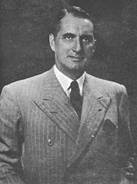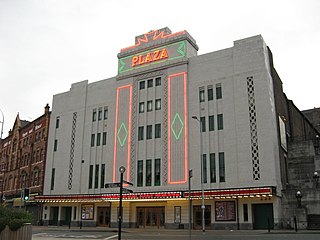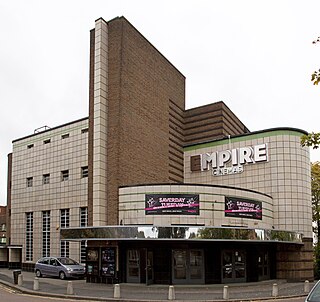
The Odeon Luxe Leicester Square is a prominent cinema building in the West End of London. Built in the Art Deco style and completed in 1937, the building has been continually altered in response to developments in cinema technology, and was the first Dolby Cinema in the United Kingdom.

The Rank Group plc is a gambling company based in the United Kingdom. Rank was involved in the cinema and motion picture industry until 2006, and continues to use the Gongman logo originally used by the Rank Organisation's film distribution subsidiary General Film Distributors. Its brands now include Mecca Bingo, and Grosvenor Casinos, the UK's largest casino operator.

Oscar Deutsch was a British businessman. He was the founder of Odeon Cinemas in 1928, with the flagship cinema, the Odeon, Leicester Square in London, opening in 1937.
Odeon, stylised as ODEON, is a cinema brand name operating in the United Kingdom, Ireland and Norway, which along with UCI Cinemas and Nordic Cinema Group is part of the Odeon Cinemas Group subsidiary of AMC Theatres. It uses the famous name of the Odeon cinema circuit first introduced in Great Britain in 1930. As of 2016, Odeon is the largest cinema chain in the United Kingdom by market share.

Harold William "Harry" Weedon was an English architect. Although he designed a large number of buildings during a long career, he is best known for his role overseeing the Art Deco designs of the Odeon Cinemas for Oscar Deutsch in the 1930s. Influenced by the work of Erich Mendelsohn and Hans Poelzig – the Odeons "taught Britain to love modern architecture" and form "a body of work which, with London Underground stations, denotes the Thirties like nothing else".

Kingstanding is an area in north Birmingham, England. It gives its name to a ward in the Erdington council constituency. Kingstanding ward includes the areas; Perry Common, Witton Lakes. The other part of Kingstanding falls under the Oscott ward.
John Cecil Clavering OBE was an English architect, best known for his work designing Odeon Cinemas as part of Harry Weedon's architectural practice in the 1930s, and his later work as the architect of the Public Record Office in Kew, London.

The Plaza is a Grade II* listed art deco single-screen cinema and theatre in Mersey Square, Stockport, England. It opened in 1932, its construction having involved the excavation of the sandstone cliff behind it. After an initial closure in 1966 and a subsequent period in use as a bingo hall by Rank Leiure, it has now been restored as a cinema and theatre, showing films and staging live shows.
Lichtburg has been a popular name for cinemas in Germany. Those in Berlin, Essen and Düsseldorf have been particularly famous; the Lichtburg in Oberhausen is the site of the International Short Film Festival Oberhausen, and Quernheim is the smallest municipality in Germany with a cinema, also called Lichtburg.

John Stanley Coombe Beard FRIBA, known professionally as J. Stanley Beard, was an English architect known for designing many cinemas in and around London.
Bradford Odeon is the name applied to two different cinemas in central Bradford, West Yorkshire, England. One, in Godwin Street, was built in 1930 and survives; the other, in Manchester Road, was built in 1938 and demolished in 1969.

The Birmingham Odeon is a cinema and former concert venue located in Birmingham, England.

The Odeon Cinema, Manchester was a former Odeon Cinema located on Oxford Street, Manchester, England. It was close to St. Peter's Square, within the Civic Quarter of Manchester city centre. It was demolished in April 2017, and replaced by Landmark, a 14-storey office building, as part of a major transformation of the area.

The Grosvenor Picture Palace, now known as the Footage, is a former cinema and current pub at the corner of Grosvenor Street and Oxford Road in Chorlton-on-Medlock, Manchester, United Kingdom. Built in 1913–15, it was the largest cinema outside London in its day. It is now a Stonegate pub.

Towers Cinema was a former cinema in Hornchurch, England. It was built in 1935 on part of the former Grey Towers estate and was noted for its Art Deco style of architecture. From 1973 it was used as a bingo hall until it closed in 2015. Despite the efforts of a local campaign to preserve the structure and to have it listed by Historic England, the building was demolished to make way for a Lidl supermarket.

The Embassy Cinema is a former cinema in the town of Chadwell Heath, Greater London. It was once known, among locals, as The Gaumont. It was designed in an art deco style, with a streamline moderne interior, by Harry Weston in 1934. The building is situated on the border of Redbridge and Barking & Dagenham, in the Chadwell Heath District Centre. The cinema closed in 1966 and became a Bingo Hall. In 2015, following the closure of the Bingo Hall, it was then used as a wedding hall/banqueting suite. The building was listed as an Asset of Community Value by the 'Chadwell Heath South Residents' Association' in August 2017 and is currently the focus of a major cinema restoration project.

The Odeon Cinema is a Grade II listed building immediately west of the city centre of York, in England.

The Empire Cinema, formerly the Odeon Cinema, is a cinema in Maney, Sutton Coldfield in West Midlands, England. Built in 1936, it is notable for its Art Deco style. It is a Grade II listed building. It closed in 2020; its future re-opening, as the Royal Cinema, was announced in December 2023.

The Odeon Cinema is a cinema in Harrogate, in North Yorkshire, England. Built in 1936, it is notable for its Art Deco style. It is a Grade II listed building.
















